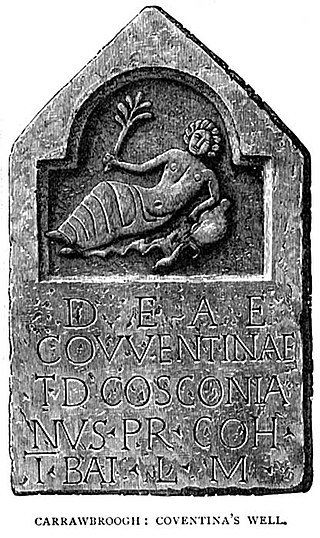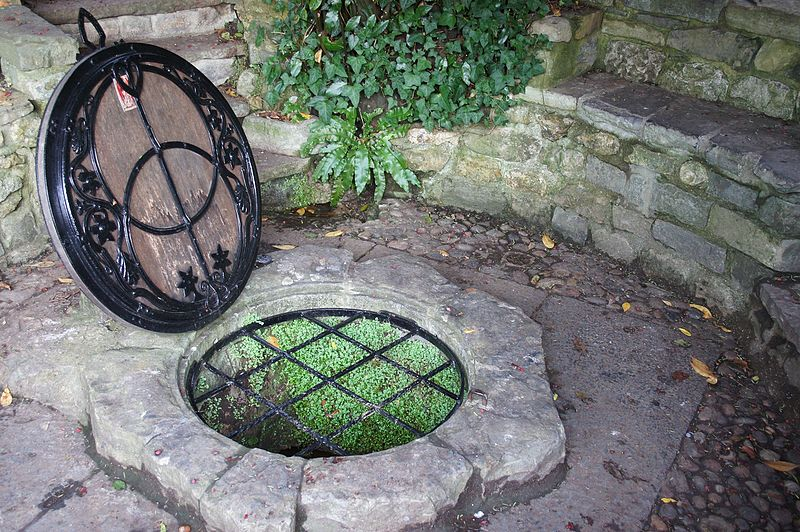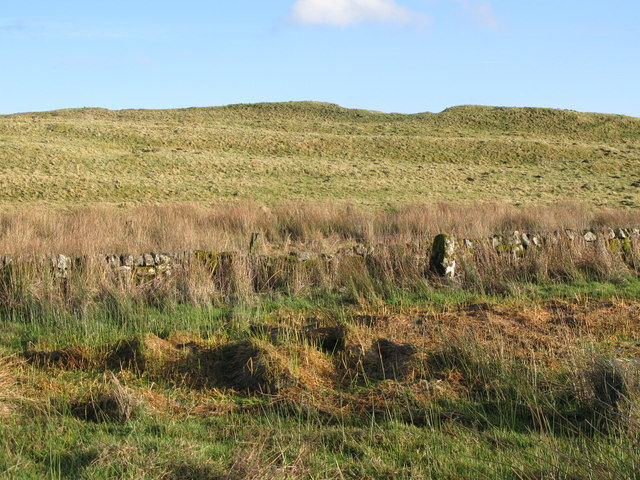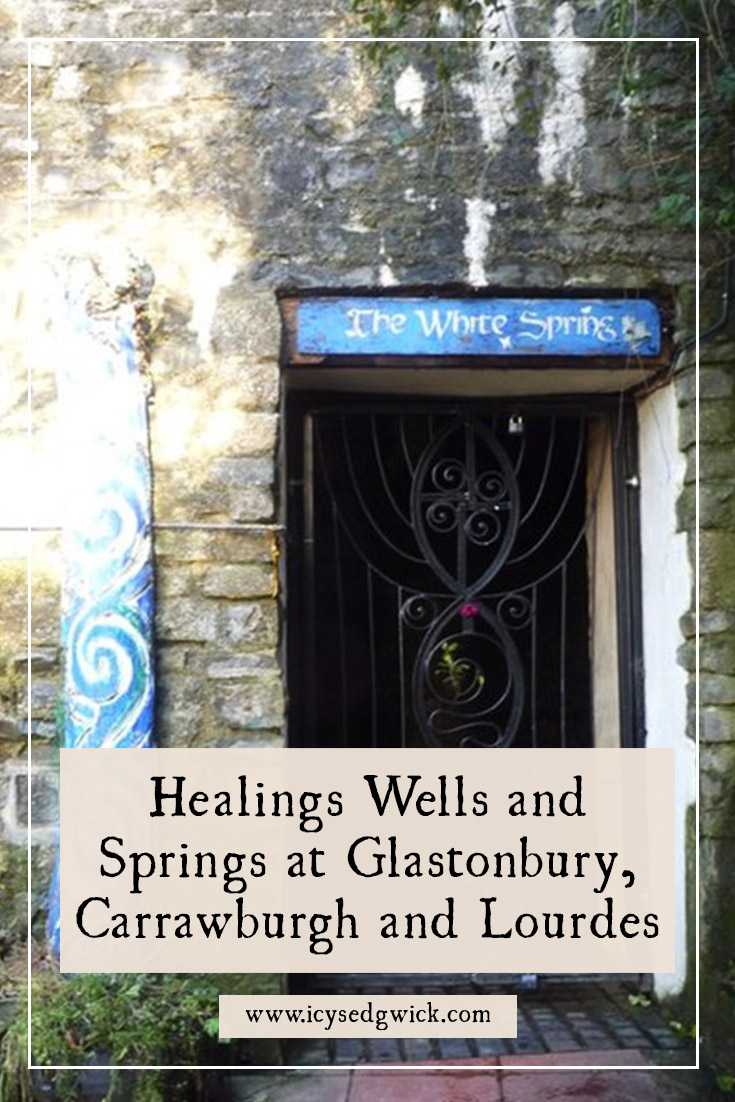We’ve no doubt seen plenty of content online about water’s power to be a great healer. We need to drink it (this is your reminder for today), while people swear by cold water baths for their wellbeing. Then we think about how much water appears in nature, somewhere we’re often counselled to go to improve our mental health. I think of how often I find myself heading towards water on my days off, whether that’s the local burn, the mighty Tyne, or the unforgiving North Sea.
But how often do we think of healing springs or wells as a potential destination?
They seemed a logical choice for this week’s entry into our Folklore of Water theme after the brief dabble with Holywell Priory last week. True, wells can also be used for other purposes, like wishing and cursing, which I’ve covered before. But here, we’ll focus entirely on four springs devoted to healing—especially of the miraculous kind.
Let’s explore the folklore of healing wells.
Chalice Well and White Spring, Glastonbury
Perhaps one of the most famous wells in England is the Chalice Well in Glastonbury. The ancient spring is sometimes called the Blood Well, and its waters are at a constant temperature of 11 degrees. It also maintains a constant flow since its origins lie far underground, so it doesn’t depend on rainfall (Chalice Well Trust n.d.). That was extremely helpful during the drought of 1921 to 1922, when the spring was the town’s sole water source. The water is also vaguely radioactive (Cromwell 2023).
So why is it called the Blood Well? Well, the water is coloured red by its iron content, although the folkloric explanation is somewhat different. In legend, Joseph of Arimathea buried the Holy Grail, containing blood from Christ’s wounds, along with nails from the cross. The blood and the rust from the nails turned the water red (Cromwell 2023).
The stones in the well shaft seem to date to the 12th century, although archaeologists note that they may also be salvaged from the abbey, so the shaft may actually not be the same age. There is also archaeological evidence to suggest people have been using the site since the Mesolithic era (Chalice Well Trust n.d.).
The White Spring
There’s also a second well nearby, often named the White Spring, which lies at the foot of Glastonbury Tor. Where the Red Well is rich in iron, the White Spring is full of calcium.
Surprisingly, the monks of Glastonbury Abbey were originally focused on the Well of St Dunstan under the abbey’s Lady Chapel. Locals just used the Red and White Springs for fresh water. Once the abbey closed, discussion of holy springs moved to the pair we know today.
In 1750, Matthew Chancellor claimed he’d had a prophetic dream that led him to drink the water from the White Spring. He did so, on every Sunday morning for seven weeks, and following this, announced he was now cured of asthma. On May 5, 1751, 10,000 people came from as far afield as Bristol and Bath to drink the spring water (Cromwell 2023).
In 1872, the town set up a reservoir for the White Spring during a cholera epidemic. Unfortunately, the town’s pipes couldn’t handle the high calcium concentration, and the reservoir became derelict (Cromwell 2023). The White Spring now hosts a temple space.
Many people also enjoy visiting the Chalice Well and its surrounding gardens. But I can’t help feeling that the spring of the Chalice Well has become buried beneath the weight of Arthurian legend and the bizarre theories people claim they discover during prophetic dreams.
It would be interesting to know what the Roman and Iron Age people made of the spring, if they simply considered it a water source, or if they also venerated a local well spirit there. Unfortunately, given the focus on Glastonbury as the site of Avalon, it’s unlikely we’ll ever know.
Coventina’s Well, Hadrian’s Wall
Speaking of Roman and Iron Age people, it’s worth looking at Coventina’s Well, near Hadrian’s Wall. We know little about Coventina, other than the fact she was a local British goddess from the area now known as Northumberland. She was important enough for the Romans to venerate her and representations of her show a Roman artistic influence.
She’s described as a patroness of healing waters and wells (Edwards 2014). To some scholars, Coventina personified the spring that fed the well in her sanctuary.

Several altars at Coventina’s Well at Carrawburgh bear inscriptions, showing they were dedicated to Coventina. The Prefectus of the First Cohort of Batavians apparently left one of them. These dedications are important to note due to the way Roman religion worked. You would petition your chosen deity for a thing, whatever that might be, and if the deity granted your petition, then you made your sacrifice and raised an altar in their name. If they didn’t grant it, then you didn’t have to dedicate an altar (Henig 1995: 59).
That said, Jane Webster points out that of the fourteen dedications, only two come from prefects. The rest come from low-ranking soldiers, suggesting her popularity among the rank and file (1995: 160). I. P. Haynes suggests the auxiliary garrison might have brought Coventina to Carrawburgh, and that she appears elsewhere in mainland Europe (1993: 155). If so, she may not have been the personification of that spring, but the people making petitions certainly associated her waters with healing.
She’s portrayed as a trinity of nymphs on one relief, which led Eric Edwards to describe her as a ‘triple goddess’ (2014). The idea of the triple goddess is a thorny one, since some goddesses do appear in triplicate, but the concept of the ‘maiden’, ‘mother’ and ‘crone’ triple goddess is a relatively new one. Edwards also suggests the trinity might depict Coventina and two nymphs (2014).
John Clayton excavated the Well at Carrawburgh in 1876. It was difficult to date the structure, but it seems the Roman Army built a stone enclosure around the spring in c. 130 CE. As well as the altars at the well dedicated to her, excavations also revealed votive offerings like brooches, coins, pottery, and rings. Bronze models of dogs and horses also appeared, which Edwards read as a representation of Aesculapius and a fertility symbol, respectively (2014).
Now, Coventina’s Well is marked on Google Maps as being in a field beside the car park near the Carrawburgh Mithraeum, and it’s actually surprising how close the two sites are. This image from 2009 shows a standing stone that marked the site. Unfortunately, the well is now lost amid hip-high grass, which is a shame given her apparent importance to Romans in the area.
Lourdes, France
It seemed only right to include Lourdes and it’s perhaps one of the most famous springs in Europe – maybe the world.
How did the spring come to be there?
In 1858, Lourdes was a small town at the foot of the Pyrenees. Marie-Bernarde Soubirous, known as Bernadette, was the eldest of six in a poor family that lived in one room.
On 11 February of that year, Bernadette went to a local grotto while collecting firewood. She saw a vision of the Virgin Mary, at the time known only as the Lady, and returned seventeen more times, seeing the Lady each time. While others went with her, no one else seemed to see the Lady. Scepticism grew among the locals.
By 25 February, the Lady told Bernadette to drink from a spring. Bernadette saw no spring, so she started digging, although she found no water. A day or two later, water appeared, and Bernadette drank the water, as instructed. Others did likewise, and its reputation for healing spread around the town.
On 27 February and again on 2 March, the Lady instructed Bernadette to tell the priests to build a chapel. People should arrive in processions. Word reached the media, and thousands of people arrived to accompany Bernadette to the grotto. By 25 March, or Lady Day, the Lady announced she was the Virgin Mary. Bernadette saw her for the last time on 16 July.
Police cross-examined Bernadette but she didn’t waver in her story. The mayor barricaded the spring, while the authorities were sceptical, although a Church commission in 1862 proclaimed the visions genuine. They approved the cult of Our Lady of Lourdes, and Bernadette joined the convent of the Sisters of Charity at Lourdes. Bernadette died in 1879, aged 35, and became a saint in 1933 (Cavendish 2008).

Healing at Lourdes
Pilgrims flocked to Lourdes, with 100,000 people attending the church’s consecration in 1876. They started work on a second church in 1883 to cope with the visitor numbers. In 1958, six million pilgrims visited Lourdes, with many hoping for healing cures. Water from the spring supplies taps at the sanctuary that’s surprisingly free to use.
Even as early as 1922, commentators noted that a string of analysts could not find any curative properties to the water – yet it still seemed to make a difference (Sutton 1922: 46). Bertha R. Sutton even posed the question that if it were mere hydropathy, why did patients using hydropathic equipment in hospitals not see the same healing effects? (1922: 46) The implication is that the water’s healing properties cannot be quantified, here provided by the Virgin Mary, much like the healing properties of Coventina’s Well apparently came from the goddess.
Sutton provided the example of a Belgian girl with no religious background who knew nothing of Catholic doctrine. Yet somehow she found herself on a pilgrimage, perhaps due to the growth on her knee and her tuberculosis. It seems a dip in the waters of Lourdes cured both (1922: 47).
According to some legends, people visited the grotto in earlier centuries, and there is a suggestion that the Romans may have made offerings there (The Archaeology & Metal Detecting Magazine 2025). The Roman artefacts found in nearby fields hint that they at least had a presence in the area. Despite that, no records show any special qualities to the water before 1858. While the Church declared more than seventy healings to be “medically inexplicable”, there’s no way to know if the healings are genuine or down to the placebo effect (The Archaeology & Metal Detecting Magazine 2025).
Have you visited either of these wells? What happened?
I would love to hear if you’ve visited any of these wells. If so, what experiences did you have? I’d especially love to hear from anyone who has actually managed to find Coventina’s Well!
Or have you heard similar legends where you are about local springs or healing wells? It would be interesting to see where these stories appear and how they relate to their location! Feel free to leave a comment below if you’ve heard such stories in your neck of the woods.
References
The Archaeology & Metal Detecting Magazine (2025), ‘Unearthing the Truth About Lourdes: Beyond the Miracles’, The Archaeology & Metal Detecting Magazine, https://archmdmag.com/unearthing-the-truth-about-lourdes-beyond-the-miracles/. Accessed 28 April 2025.
Cavendish, Richard (2008), ‘Saint Bernadette’s First Vision at Lourdes’, History Today, https://www.historytoday.com/archive/months-past/saint-bernadette%E2%80%99s-first-vision-lourdes. Accessed 28 April 2025.
Chalice Well Trust (no date), ‘A brief history of Chalice Well’, Chalice Well Trust, https://www.chalicewell.org.uk/our-history/a-brief-history-of-chalice-well/. Accessed on 11 April 2023.
Cromwell, Bob (2023), ‘White Spring, Chalice Well and Glastonbury Tor’, Bob Cromwell, https://cromwell-intl.com/travel/uk/glastonbury/chalice-spring-tor.html. Accessed 11 April 2023.
Edwards, Eric W (2014), ‘The Goddess Coventina of Northumbria’, Eric Edwards Collected Works, https://ericwedwards.wordpress.com/2014/04/11/the-goddess-coventina-of-northumbria/.
Haynes, I. P. (1993), ‘The Romanisation of Religion in the ‘Auxilia’ of the Roman Imperial Army from Augustus to Septimus Severus’, Britannia, 24, pp. 141–57.
Henig, Martin (1995), Religion in Roman Britain, London: Batsford.
Sutton, Bertha R. (1922), ‘Lourdes’, The Irish Monthly, 50 (584), pp. 45–50.
Webster, Jane (1995), ‘‘Interpretatio’: Roman Word Power and the Celtic Gods’, Britannia, 26, pp. 153–61.
Nutty about folklore and want more?
Add your email below and get these posts in your inbox every week.
You'll also get my 5-step guide to protecting your home using folklore!










Have your say!